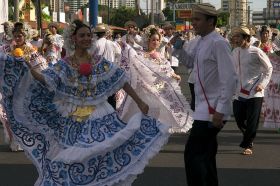What are the traditions of El Valle de Anton, Panama?
Luris Espinoza
Anton Valley (where El Valle is located in Cocle Province of Panama) has many different traditions. One of the most important traditions honors our saint of the region, San Jose. The holiday to honor San Jose is celebrated March 19, with festivities beginning March 10.
Here are some other traditions in our area:
- Starting just three years ago, every August we celebrate the the Festival of the Frog...
Anton Valley (where El Valle is located in Cocle Province of Panama) has many different traditions. One of the most important traditions honors our saint of the region, San Jose. The holiday to honor San Jose is celebrated March 19, with festivities beginning March 10.
Here are some other traditions in our area:
- Starting just three years ago, every August we celebrate the the Festival of the Frog Guild, sponsored by the Center of Conservation of Amphibians in order to create awareness among the entire population of Panama of the many frog species that are in danger of becoming extinct.
- The traditional Parade of Wagons, which honors the men and women who work in the fields.
- We have parades November 3 and 4 throughout Panama to honor to the motherland on its separation from Colombia in 1903, some of which take place in Anton's Valley.
Posted January 17, 2014
Adam Brunner - abc realty panama
 The traditions in El Valle de Anton are pretty much the traditions that Panamanians have nationwide. The Carnivales, the Easter weekend, the Week of the Campesino (which is the field hand, the worker), are just some of the traditions. In October, they dress the children up in polleras and montunos, and they do little dances. They get rewards for the best job or best costume.
The traditions in El Valle de Anton are pretty much the traditions that Panamanians have nationwide. The Carnivales, the Easter weekend, the Week of the Campesino (which is the field hand, the worker), are just some of the traditions. In October, they dress the children up in polleras and montunos, and they do little dances. They get rewards for the best job or best costume.“Montunos” is an older Panamanian term that refers to a field hand, who is wearing his traditional...
 The traditions in El Valle de Anton are pretty much the traditions that Panamanians have nationwide. The Carnivales, the Easter weekend, the Week of the Campesino (which is the field hand, the worker), are just some of the traditions. In October, they dress the children up in polleras and montunos, and they do little dances. They get rewards for the best job or best costume.
The traditions in El Valle de Anton are pretty much the traditions that Panamanians have nationwide. The Carnivales, the Easter weekend, the Week of the Campesino (which is the field hand, the worker), are just some of the traditions. In October, they dress the children up in polleras and montunos, and they do little dances. They get rewards for the best job or best costume.“Montunos” is an older Panamanian term that refers to a field hand, who is wearing his traditional Panamanian best-dress outfit, which is a white guayabera (a traditional shirt, pictured above), black slacks and Panamanian sandals. Polleras (pictured above) are what the Panamanian women wear. These are fancy dresses with the elaborate and really cool headdresses. And they put jewelry in their hair, too. The dance they do is what they have been doing for the last 100 years. The adults teach this to the kids, who would teach it to their kids when they get old enough.
The Week of the Campesino is basically just in the local school district, the elementary school area, and gears the kids up for the big parties in November. It’s not necessarily available to the public or advertised to the public. It’s mainly for the kids and the parents, but if you’re there, nobody will object if you stand by and watch it.
During November, there are lots of parades. The other holidays in that month celebrate independence from Spain, independence from Colombia, and independence from the United States. If I can remember correctly, they have five holidays in November.
Posted February 21, 2015


